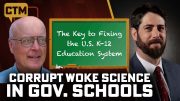According to the “I am an educator” website, Nathan Hale High School in Seattle has taken the lead in resisting the new “Smarter Balanced Assessment” Common Core Tests being pushed on the high schools in the city. Common Core is a school curriculum that is meant to be followed lockstep, which its proponents claim will make schools more rigorous, students smarter, and the country stronger. They claim that states have been getting onboard with the plan of their own volition, because the curriculum is just better. Opponents claim that the plan is being foisted on the schools by the federal government, that its teaching methodologies are flawed, that its main goal is to get students to all believe the same ideals, and that it means less true thinking for students.
Educators at Garfield High School, where the rebellion against standardized testing began, sent an open letter of thanks to their counterparts at Nathan Hale for coming out so strongly against this nine-hour monster of a test. They stated:
We are writing to congratulate you for taking a bold stand against the Smarter Balanced Assessment Consortium testing. Your school Senate’s vote to oppose the SBA has helped many all across Seattle find the courage to join this growing movement for authentic assessments.
Where did these tests come from? Where else but from the U.S. Department of Education, proving beyond any doubt that this is part of the federal takeover of America’s local public schools. The Race to the Top Assessment Program, authorized in 2009 by the American Recovery and Reinvestment Act, provided funding for these tests that would measure student achievement against the new Common Core standards. A PDF government document states:
In September of 2010, the U.S. Department of Education awarded two Comprehensive Assessment Systems grants to the Partnership for Assessment of Readiness for College and Careers (PARCC) Consortium and the Smarter Balanced Assessment Consortia (SBAC). The consortia are to develop and implement assessment systems by the 2014-2015 school year. In addition, PARCC and SBAC were each provided a supplemental grant award to support the work in their approved application and to successfully transition to the new standards and assessments.
In other words, this is the federal government’s not so subtle way of taking complete control of American education by financing assessment tests tied to the Common Core curriculum. To what extent student and educator resistance to these tests will put a stop to this federal takeover is still to be seen. According to Education Week, so far, $360 million in federal grants has gone to 37 states to implement the tests. However, 15 states have rejected the program: Texas, Oklahoma, Kansas, Utah, Arizona, Minnesota, Kentucky, Virginia, Tennessee, Alabama, Georgia, South Carolina, Florida, Alaska, and Hawaii.
Who are some of the educational bureaucrats in charge of this federal program? Jeffrey Nellhaus, who holds a masters degree from Harvard Graduate School of Education and a doctorate degree from the University of Maryland, is director of PARCC (Partnership for the Assessment of Readiness for College and Careers). According to the PDF:
Before joining PARCC, Mr. Nellhaus spent nearly 25 years with the Massachusetts Department of Elementary and Secondary Education [MA DESE] where [he] held the positions of Deputy Commissioner, Acting Commissioner, and Associate Commissioner for Curriculum and Assessment. While at the MA DESE, Mr. Nellhaus directed the design, development and implementation of the Massachusetts Comprehensive Assessment System (MCAS), and the development of the Massachusetts Curriculum Frameworks, which include the Common Core.
Nellhaus is a true establishment bureaucrat who will implement whatever the federal government wants. Another such dedicated functionary is Joe Wilhoft, executive director of the Smarter Balanced Assessment Consortium. Prior to this appointment, he was assistant superintendent for assessment and student information for Washington State. His job is to develop new state assessment systems aligned to the Common Core State Standards. The PDF states:
He is past president of the Maryland Assessment Group, the Washington Educational Research Association, and the American Educational Research Association Classroom Assessment Special Interest Group. He has been involved in multiple collaborative data and assessment efforts, including having served on technical advisory committees in several states and the Technical Work Group for the most-recent congressionally-mandated evaluation of the National Assessment of Educational Progress (NAEP). He previously served as co-chair of the NAEP Policy Advisory Task Force, a collaborative effort of the National Assessment Governing Board and the Council of Chief State School Officers.
In other words, Wilhoft has spent his entire professional life in educational testing on every level possible. When I was going to public school in New York City in the 1930s and ’40s, the only tests we took were the ones given us by our teachers, who wanted to know if we were learning what they were teaching. Since they were teaching the basic traditional curriculum in reading, writing, and arithmetic, they could easily keep track of every student’s progress. At the end of high school, we were all required to take the state’s Regents Test in order to get our diploma. I don’t recall many not passing that test, which was taken with pencil and paper.
Fast forward to the age of computer technology. From March 25 to June 13, 2014, more than 4.2 million students, 16,549 schools, and thousands of teachers have participated in the Smarter Balanced Field Test — the largest online assessment ever. And the technology worked well.
Nevertheless, two high schools in Seattle have decided not to participate in the tests, complaining that they take too much out of learning time. They believe that 60 percent of the students who take the test will fail in math and reading. They explain:
We believe in high expectations and supporting our students to reach ambitious goals. We do not believe in rushing to implement an exam — one that has not even yet been shown to be reliable by the test maker’s own admission — that will result in mass failure and demoralization of children.
New York officials recently released the results of the state’s 2014 Common Core State Standards-aligned exams. Carol Burris, principal of South High School in Rockville, explained what they mean in the Washington Post online August 27, 2014:
The data show that about 31 percent of the state’s students in third through eighth grades met or exceeded the proficiency standard in language arts. That is down from about 55 percent in 2012 and 77 percent in 2009, when the state tests were easier.
The achievement gap remains a problem. In language arts, for example, 50.4 percent of Asians, 39.9 percent of whites and 16.1 percent of African-Americans were performing at or above the proficiency level.
The only good news for ELA was that the achievement gap between white and black proficiency rates narrowed a bit. However, a narrower gap, achieved predominantly through lower scores of the higher performing group, is not the strategy of choice. The proficiency rate for white students dropped two points (38 percent), and the proficiency rate for black students went up one point (17 percent).
Not very encouraging, to say the least. Either the tests aren’t well related to what the students are studying — which would mean that Common Core is poorly designed or administered — or the tests are reflective of what the students are studying and the new curriculum is not properly addressing students’ learning needs. What the tests clearly indicate is the intention of the federal test developers to make the Common Core and its tests the foundation of a national curriculum for American education. It will be interesting to see how resistance to the tests continues to swell in the months ahead.




